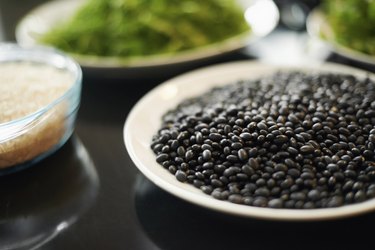Eating Beans On Low Carb Diet

Beans provide a wealth of nutrients, including vitamin B, fiber and protein.
Image Credit: PeopleImages.com/DigitalVision/Getty Images
For people following a low-carbohydrate or ketogenic diet, beans can be a bit of a puzzle. Although they provide essential nutrients and health benefits, they are also high in carbs. In fact, most types of beans are off-limits for strict low-carb and ketogenic meal plans, at least for the first few weeks.
Nutrition experts warn that dieters shouldn't swear off beans entirely, though. The key is learning what types —and portions — can fit into your daily carb allowance, and understanding the healthiest (and tastiest!) ways to eat them.
Why Beans Are Important to Health and Weight Loss
Beans provide a wealth of nutrients including fiber and protein, both strongly associated with satiety and weight management. A cup of black, pinto or garbanzo beans (also known as chickpeas) provide approximately 15 grams of protein and between 12 and 16 grams of fiber, according to the U.S. Department of Agricultural Research Service (USDA).
You'll also get high amounts of B vitamins like folate and thiamine in a servings of beans. The B vitamins help your body release energy from food, and folate works with B-12 to manufacture red blood cells, according to the National Institute on Aging. Black beans, pinto beans and chickpeas are also excellent sources of minerals such as iron, magnesium, potassium and manganese.
The Low-Down on Beans and Low-Carb Diets
You might eat anywhere from 20 to 100 grams of carbs a day on a low-carb diet, depending on the plan. With those numbers in mind, it's easy to see how it can be difficult to fit beans into your daily allowance: A cup of cooked beans contains 40 grams of carbs or more.
If you're calculating "net" carbs — the amount of total grams of carbs minus grams of fiber — beans are still considered high, supplying somewhere in the vicinity of 25 grams per cup.
"You might include beans in a more moderate low-carb diet, but you can't really have them — or other legumes like peas and lentils — if you're following a ketogenic diet and you're trying to get into or stay in ketosis," says Franziska Spritzler, RD, author of The Low-Carb Dietitian's Guide to Health and Beauty.
There's one exception to that rule, however. Green beans (also known as string beans) contain just six grams of carbs per three quarter–cup serving, according to the USDA. In fact, green beans are often coupled with vegetables such as onions, lettuce, celery and cabbage (instead of with other beans) because their nutrient content is similar to those foods, according to MyPlate.
Because of their low carbohydrate content, green beans are fair game no matter how strict your low-carb diet is or what phase you're in. "You can eat these liberally," says Spritzler. "They're great raw, as a snack or sautéed as a side dish."
Beans as a Salad, Side Dish and Snack
If you're following a less restrictive low-carb diet or you're past the initial phase that restricts foods like beans, it's smart to start incorporating beans into your meals. To get you started, follow this simple rule of thumb: Use a quarter-cup for your serving size to control the number of carbs you're getting at any one time.
One way to choose beans on a low-carb diet is to use them as a filling addition to a mixed green salad for lunch. Greens of all varieties are very low in carbs and are allowed in abundance.
Top two cups of leafy greens with a lean protein like grilled salmon, a quarter-cup of black beans seasoned with cumin and chili powder and a half cup of low-carb veggies like tomatoes. Slice on a serving of avocado and top with jalapeño ranch dressing for a Mexican-inspired low-carb lunch.
Another way to choose beans is to make a cold side dish to complement your protein and non-starchy vegetables at dinner.
Start with a cup of pinto beans, and add generous amounts of fresh chopped celery, red onion, red bell pepper and cilantro. Finish the cold bean dish with a vinaigrette made with olive oil and balsamic vinegar. Serve a quarter cup portion on the side of grilled chicken or sirloin, plus a cup of steamed asparagus or Brussels sprouts.
You can also snack on beans on a low-carb diet. Dip broccoli florets or celery sticks into 2 tablespoons of prepared hummus — a spread made with mashed chickpeas, garlic, tahini, lemon and spices. Or try roasting cooked chickpeas with olive oil, salt and spices; the beans become satisfyingly crispy and just right for snacking.
Beans: The Musical Fruit?
If you're not used to eating a lot of beans or other foods rich in fiber, you may experience higher levels of gas and bloating when you first start eating them regularly. Fortunately, most people will notice that their gastrointestinal functioning returns to normal within a few weeks once their bodies gets used to the added fiber, according to the Cleveland Clinic.
To help minimize these problems, Mayo Clinic recommends preparing beans from scratch by soaking them, then throwing away the soaking liquid and cooking them in a fresh pot of water. This can help rid the water (and therefore the beans) of some of the indigestible carbohydrates that produce gas.
If you prefer canned beans, that's fine too. The canning process breaks down some of those same indigestible carbohydrates, reports the Mayo Clinic. Whether you use canned or dried beans, always cook them until they're tender; this makes them easier to digest.
Taking a digestive aid, such as Beano, may be helpful for some people, as well. Anytime you add fiber to your diet — like the generous amounts you'll get from beans — be sure to drink plenty of water to avoid cramping and discomfort, suggests Spritzler.
Source: https://www.livestrong.com/article/11802-choose-beans-low-carb-diet/

0 komentar:
Posting Komentar